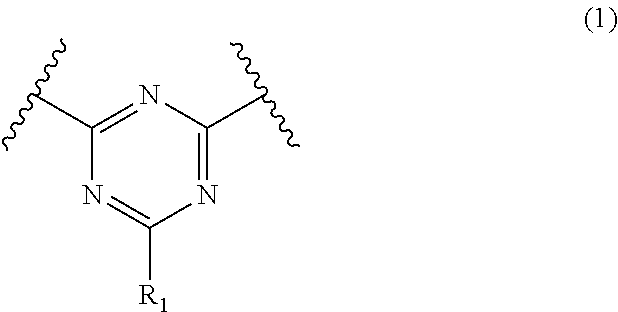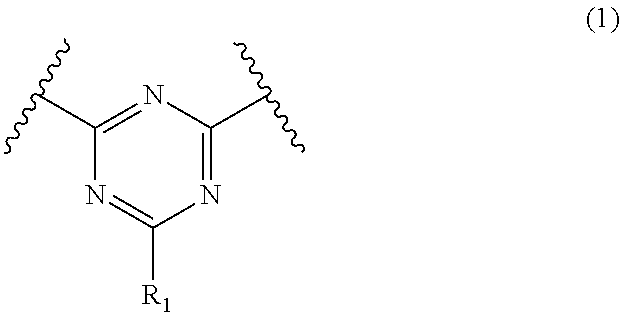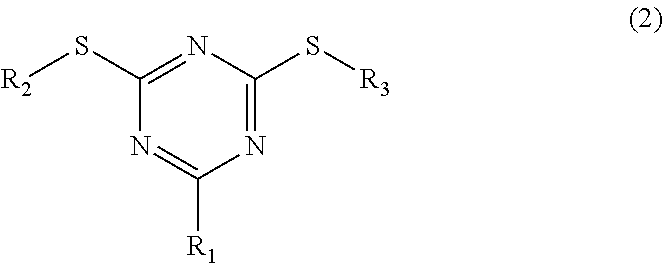Organic-inorganic hybrid composition, and article and optical component including the same
a hybrid composition and organic technology, applied in the field of organic-inorganic hybrid composition and an article and an optical component, can solve the problems of insufficient strength of the obtained article, difficult uniform dispersal of inorganic particulate, limited practical use of inorganic particulate, etc., to achieve the effect of reducing the difficulty of inorganic particulate dispersal, reducing the difficulty of inorganic particulate dispersibility, and improving the refractive index of the surfa
- Summary
- Abstract
- Description
- Claims
- Application Information
AI Technical Summary
Benefits of technology
Problems solved by technology
Method used
Image
Examples
examples
[0140]Hereinafter, the present disclosure is illustrated in detail by using Examples but is not limited thereto. As used herein, “part” indicates “part by weight” unless it is particularly specified.
Evaluation Methods
[0141]Number Average Molecular Weight (Mn) and Weight Average Molecular Weight (Mw))
[0142]A measurement sample is prepared by dissolving a polymer in tetrahydrofuran (THF) to have a concentration of 0.1 wt % and filtering the solution with a polytetrafluoroethylene membrane filter having a pore size of 0.2 micrometer (μm). A number average molecular weight and a weight average molecular weight of the sample are measured through gel permeation chromatography (GPC) of tetrahydrofuran as a mobile phase with a differential refractometer as a detector. Monodisperse polystyrene is used as a standard material of a molecular weight. Units for molecular weight as used herein are grams per mole (g / mol).
[0143]Glass Transition Temperature (Tg)
[0144]A glass transition temperature (T...
synthesis example 2
ne Ring-Containing Polymer [1]
[0153]2.00 grams (g) (8.46 millimoles, mmol) of 2-anilino-1,3,5-triazine-4,6-dithiol (ZISNET AF, Sankyo Kasei Co., Ltd.) is put in a 100 milliliters (mL) flask, 14 mL of pure water is added thereto, 1.69 mL of a 10 molar (M) NaOH aqueous solution is added thereto, and the mixture is heated at 70° C. 2.23 g (8.46 mmol) of α,α′-dibromo-p-xylene is dissolved in 15 mL of nitrobenzene, and the obtained solution is added to the aqueous solution. 123 milligrams (mg) of hexadecyltrimethyl ammonium bromide is added thereto, and the mixture is fervently stirred at 70° C. for 24 hours. The reaction solution is added to methanol in a dropwise fashion and reprecipitated to obtain a white triazine ring-containing polymer [1]. The obtained triazine ring-containing polymer [1] has a number average molecular weight: 60000, a weight average molecular weight: 125000, Tg: 125° C., and a refractive index (nD, 587.6 nm): 1.729.
[0154]
synthesis example 4
onium Oxide Particulate (Dn50=3 nm) / N-(2-Aminoethyl)-3-Aminopropyl Trimethoxysilane / Dimethyl Acetamide
Dispersion
[0155]100.00 parts by weight of a zirconium oxide / methanol / acetic acid dispersion (a number median diameter of primary particles: 3 nm, a refractive index of zirconium oxide: 2.1, a solid content (zirconium oxide): 30 wt %, SZR-M, Sakai Chemical Industry Co., Ltd.) and 4.00 parts by weight of a silane coupling agent, N-(2-aminoethyl)-3-aminopropyl trimethoxysilane (KBM-603, refractive index: 1.441, Shin-Etsu Chemical Co., Ltd.) as a surface-treating agent are put in a separable flask equipped with a stirrer and a thermometer and then stirred at 35° C. for 1 hour. Subsequently, the dispersion is concentrated by an evaporator until the solid content is 90 wt % and methanol and acetic acid are distilled and removed therefrom to obtain white powder. The powder is washed with hexane and filtered to remove surplus acetic acid and N-(2-aminoethyl)-3-aminopropyl trimethoxysilane t...
PUM
| Property | Measurement | Unit |
|---|---|---|
| number median diameter | aaaaa | aaaaa |
| refractive index | aaaaa | aaaaa |
| refractive index | aaaaa | aaaaa |
Abstract
Description
Claims
Application Information
 Login to View More
Login to View More - R&D
- Intellectual Property
- Life Sciences
- Materials
- Tech Scout
- Unparalleled Data Quality
- Higher Quality Content
- 60% Fewer Hallucinations
Browse by: Latest US Patents, China's latest patents, Technical Efficacy Thesaurus, Application Domain, Technology Topic, Popular Technical Reports.
© 2025 PatSnap. All rights reserved.Legal|Privacy policy|Modern Slavery Act Transparency Statement|Sitemap|About US| Contact US: help@patsnap.com



